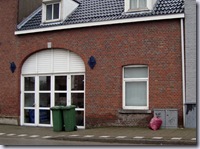One of the most convoluted things to learn when I moved to the Netherlands was how to navigate the trash collection process.
In the US, it’s pretty straightforward. I have a recycle bin, a yard waste bin, and a trash bin. Mixed cans, bottles, and paper go into the recycle bin; everything else is bagged and goes into the trash bin. On the designated morning, we position the three rolling bins at the street, handles outward, and the three corresponding trucks cruise by, lift and dump, and the bill comes at the end of the month.
The Netherlands is all different.
Household waste:
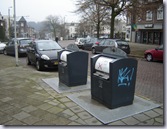 In Arnhem, I carried household waste to the communal deposit points about a block away. ‘Open the clamshell and drop the bags in; large things might need to stack between the drop bins (with guilt).
In Arnhem, I carried household waste to the communal deposit points about a block away. ‘Open the clamshell and drop the bags in; large things might need to stack between the drop bins (with guilt).
 In Maastricht, I buy special “Red” trash bags from the Albert Heijn for about ten euros a bundle. The cost of trash pickup is built into the price paid for the bags, and I deposit whatever bags I’ve filled outside my apartment door on the designated Trash Day. Normally I fill one a week, but it’s not unusual to see small mountains of bags along the streets for pickup.
In Maastricht, I buy special “Red” trash bags from the Albert Heijn for about ten euros a bundle. The cost of trash pickup is built into the price paid for the bags, and I deposit whatever bags I’ve filled outside my apartment door on the designated Trash Day. Normally I fill one a week, but it’s not unusual to see small mountains of bags along the streets for pickup.
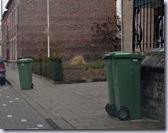 Some households (elderly and special needs in Arnhem) can pay a monthly fee to get a green bin for their household waste. This can be wheeled to the street each week for pickup.
Some households (elderly and special needs in Arnhem) can pay a monthly fee to get a green bin for their household waste. This can be wheeled to the street each week for pickup.
I was given a pass for the apartment that gave me the right to drop larger amounts of household waste at the city dump without paying a special fee. I’m afraid I lost it.
Recycling:
As near as I can tell, yard waste is composted, drink cartons are sometimes recycled, and paper and bottles must be recycled.
The process is a throwback to the situation ten years ago in the US, when we had to separate waste by type, color, and destination into multiple bins. 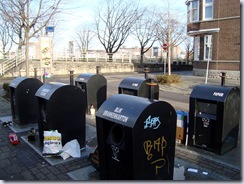 In Arnhem, newspaper and cardboard needed to be separated and left by the street once a month; in Maastricht, paper is mixed and left at neighborhood collection points. Both cities require bottles to be separated into Wit, Groen, en Brun and put into separate collection bins. Cans were not recycled in Arnhem; there is a bin for them in Maastricht.
In Arnhem, newspaper and cardboard needed to be separated and left by the street once a month; in Maastricht, paper is mixed and left at neighborhood collection points. Both cities require bottles to be separated into Wit, Groen, en Brun and put into separate collection bins. Cans were not recycled in Arnhem; there is a bin for them in Maastricht.
The collection points can get a bit…undifferentiated (above): the slots for depositing recyclables are small and people leave things alongside the bins if they won’t fit. The occasional trash-picker will pass through to scavenge these remains.
Penalties and confusions:
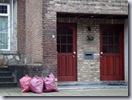 There is a calendar sent by the waste management company, with dates marked using triangles, squares, circles, and highlights, that is supposed to alert me what to do, when. It’s completely impenetrable.
There is a calendar sent by the waste management company, with dates marked using triangles, squares, circles, and highlights, that is supposed to alert me what to do, when. It’s completely impenetrable.
Woe if I put the wrong trash curbside on the wrong day: the neighbors will visit to explain what I am doing wrong and to show, in great detail, how to do things correctly.
If I put a recyclable into a trash bag, I’ll get a notice when it’s discovered. Apparently, they read the name and address off of miscreant envelopes in the trash bags and log violators.
I confess that I have, on occasion, loaded my car with cardboard box remains and driven across town at 2 am to leave them at a different neighborhood collection point.
I don’t know where to recycle plastic bags. Fortunately, I tend to carry my own bag for groceries when I go shopping so I don’t accumulate as many of them (just the required vegetable bags for weighing and tagging produce everywhere except Albert Heijn).
Wax drink containers probably do need to be recycled, but I can’t figure out how. Similarly, I suspect that some plastic containers may need to be, but it’s about as hard to sort out as it used to be in the US when we looked at the bottoms of the containers, recycling Type 1’s and 2’s, but not 4’s and 5’s.
…And nobody, yet, worries about the street waste from their dogs. I really hope that changes.

